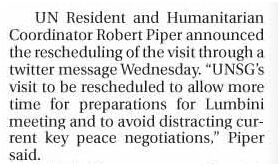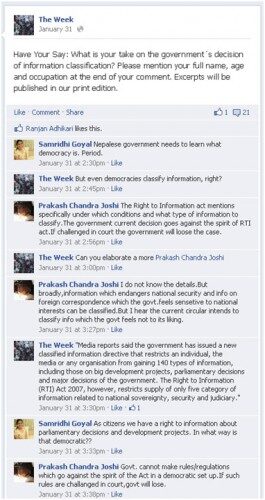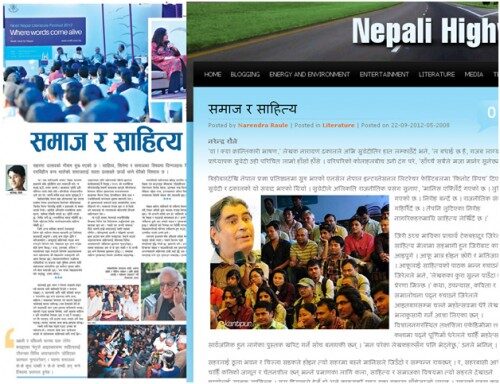(In October/November, 2012, I traveled around the country to train journalists on use of social media. The training, held by Equal Access Nepal and funded by UNDP’s project, was held in Biratnagar, Kathmandu, Pokhara, Dhangadhi & now I am in Nepalgunj. Each training lasted two days and included around 30 journalists. Here is one of the reading materials I wrote for the training. I will upload some others soon.)
Journalists can use social media to aid to their work as journalist and to improve their professional skills. Here are six things that journalists and their organizations can do with social media to aid to journalistic processes:
The six things discussed here are 1. Seek idea and information, 2. Cultivate sources, 3. Verify Information, 4. Publish / Distribute News, 5. Promote Write-ups / get feedback / measure popularity.
1. Seek ideas & information
UNSG’s visit to be rescheduled to allow more time for preparations for Lumbini meeting & to avoid distracting current key peace negotiations
— Robert Piper (@UN_Nepal) March 21, 2012
On March 21, 2012, UN’s Robert Piper tweeted that scheduled visit of UN General Secretary was postponed. Online news portals that day and newspapers next day, including Republica (shown below), used his tweet as the source.
 Social media can not only be used as source of information but also can be used to get an idea on issues and events.
Social media can not only be used as source of information but also can be used to get an idea on issues and events.
During the extended plenum of UCPN (Maoist), the party used Twitter (@UCPNMaoist) for public updates on what’s going on in the plenum. Though it’s one-sided information and not complete/concrete, it could give an idea on what’s going on or at least when to rush to the venue.
For official information and issuance of press releases, it’s easier if you follow organization’s social media profiles or that of those who are in higher position at the organizations.
If you follow people with strong opinions and knowledge on your beat, you are more likely to get peg for your next reporting. Remember, Twitter alone cannot be a complete source of information (except in some cases of breaking news like the one talked above) but it could be a tool to give you a lot of ideas for your work.
2. Cultivate Sources / Crowd source opinions
 On right, The Week of Republica uses Facebook profile to crowd-source opinions on government’s decision of information classification on January 31, 2012 (they have long stopped doing that from this particular account but still do it at www.facebook.com/gennextnepal).
On right, The Week of Republica uses Facebook profile to crowd-source opinions on government’s decision of information classification on January 31, 2012 (they have long stopped doing that from this particular account but still do it at www.facebook.com/gennextnepal).
The Week still does crowd-source opinion through Twitter asking publicly if someone has an opinion on the specific issue.
This is a good example of how social media can be used to cultivate sources and crowd source opinions.
However, to cultivate sources, its better that you befriend your potential sources (on Facebook) and follow your potential sources (on Twitter) and keep conversation even when you do not want to use them.
Like their posts, comment on their posts, retweet their tweets or reply to them just to keep the bond so when you require any information, they feel they are giving it out to a friend – rather than an unknown journalist.
Finding people who could be sources on your beat, keeping in touch with them and following what they are saying was never so easy both in terms of costs and time consumed.
On other thing that can be done on social media by crowd-sourcing is locating the right source of information. Ask people to provide you more information on specific topic, and ask them to provide you contact with right person with that information.
3. Verify Information
Verification of information you already have is normally done through asking people who may know the issue about the authenticity or asking the crowd if that was true.
4. Publish / Distribute / Archive News

On September 22, 2012, Narendra Raule wrote an article about Nepal Literature Festival on Koseli. The article was also available on his blog (the picture above shows the photo of article on newspaper and on his blog). Many journalists are using blogs to archive their news (caution: ensure with your organization that this is not a problem).
However, journalists are also increasingly using social media – especially blogs – to publish their stories and opinions.
What if the news you did for your paper do not get the space for some reason? Publish yourself. What if you are out of profession for a certain period of time? Publish it online (to keep yourself being identified as journalist and/or continue your engagement with issue/sources).
Social media is a medium of publication and distribution of news you may have (that may or may not have been published in your medium.
5. Promote Write-ups / Get feedback / Measure popularity
Social media has changed the way information is received. Audience increasingly get information through social media (in other words, information has to reach them) rather than any other way (they are decreasingly searching for information they don’t know).
This makes social media a must-tool for promotion of any published stories. On left, the screenshots show two journalists and two politicians promoting their write-ups.
Journalists can receive feedback on write-up through replies on Twitter and comments on Facebook. A story not shared on social media is more likely to end up without any feedback to the journalist but a story shared on social media is surely to draw some feedback.
The retweets and favorites received on Twitter and the likes/comments received on Facebook/YouTube also measures the popularity of the write-up.
Three Ways to Share:
1. Share headline & link (ok method): as used by many news organizations in their Facebook page; Gagan Thapa in an example here. It could draw people to click on the link and get to the story.
‘??????????’ ?? ????????? ????? ???????? | ?????/????????? |ekantipur.com/nep/2069/6/8/f…
— Gagan Thapa (@thapagk) September 24, 2012
2. Personalize with ‘my’ (good method): as used by Narayan Wagle. When personalized using ‘my’ or ‘please’ or ‘request to read’, it’s more likely to get attention (after all social media is social). But be sure to give an idea of what it’s about. Instead of saying ‘read my article’, say ‘read my article about Kathmandu’s garbage problem’ is better.
My take on govn’s self centered decision to honor ramarajabit.ly/RAl0Gb
— narayan wagle (@narayanwagle) September 20, 2012
3. Ask for action (excellent method): as used by Kunda Dixit. Ask your audience (who are your circle of friends) to act either my doing something or giving opinion. If Narayan Wagle had tweeted ‘My take on govn’s self-centered decision to honor ramaraja bit.ly/RAloGb What you think? Am I right?’, it’s more likely to generate conversation.
If you read these stories about Pushpa Basnetnepalitimes.com/issue/2011/09/… andnepalitimes.com.np/issue/2006/01/…, you will vote on CNN Heroes to encourage her.
— Kunda Dixit (@kundadixit) September 22, 2012
Download the PDF version that was distributed during the training here: How can journalists use social media. The accompanying presentation is here.
0 responses to “How can journalists use social media?”
The journalism training was great at Nepalgunj, it won’t felt that of we were boring during the training and in fact it happens to all my friends. Sitting at one room whole day passed so quickly because we were also learning and participating. Thanks sir.And here is no of our photo.
This is really a nice article and want to add a bit to it..
I would like to incorporate the whole New Media as a platform for generating News content too by the traditional media outlets. This also makes the media houses to run on few reporters that would ultimately assures its sustainability too. Participatory or the citizen journalism practice can be a boon in the case of breaking news and also in the case when reporter cannot reach the spot to witness things. So we need to adopt the New Media so as to complement the traditional media to give a pro-people news and information.
????
Derma Veil ® ????????????????????PLLA??? 2003???Mexican Ministry of Health (SSA)?????FDA???????2006???????????????????????????????????????(?????)?????????????????????????????????????????????????????????? : 1. ???? (Poly-L-lactic acid / PLLA) : ??????? 2. ???(Glycolic Acid ) ????????????????????????????????????????????????????? ???????????????? ???: ?????/?? ???: ?????????????????????????? ??BOTOX(???)????????????????????(Acetylcholine)??????????????????????????????
Etude House ???????? (??) Etude House ???????? 50ml #????????????20ml
I as well as my buddies ended up checking the good guides found on your web blog and so instantly came up with a terrible feeling I never thanked the web blog owner for those techniques. All of the people were so happy to read them and already have without a doubt been having fun with them. Thank you for indeed being really thoughtful and also for choosing varieties of superior subjects millions of individuals are really wanting to be informed on. Our own sincere apologies for not saying thanks to earlier.
I definitely wanted to make a note to thank you for all of the marvelous secrets you are placing on this site. My rather long internet lookup has at the end of the day been compensated with extremely good facts to go over with my friends. I would tell you that many of us visitors are unquestionably fortunate to exist in a wonderful community with very many lovely individuals with very beneficial techniques. I feel quite privileged to have used your entire web pages and look forward to some more fun times reading here. Thanks again for everything.
I have to express appreciation to this writer just for rescuing me from this type of trouble. After researching through the the web and coming across ways that were not beneficial, I assumed my life was over. Existing without the presence of strategies to the difficulties you’ve fixed by way of your main guide is a serious case, and the kind that could have adversely affected my career if I had not come across the website. Your good skills and kindness in maneuvering all the stuff was vital. I’m not sure what I would have done if I hadn’t encountered such a thing like this. It’s possible to at this time look ahead to my future. Thanks for your time so much for the impressive and effective help. I will not think twice to refer the blog to any individual who needs and wants assistance on this topic.
I truly wanted to develop a remark to say thanks to you for those magnificent tips and tricks you are showing at this website. My particularly long internet research has at the end been rewarded with extremely good tips to share with my friends and family. I ‘d repeat that most of us visitors actually are quite blessed to dwell in a fantastic place with many outstanding professionals with helpful ideas. I feel pretty grateful to have used the web pages and look forward to so many more enjoyable moments reading here. Thanks once more for everything.
????????????????
[??] ?????????????Gaston Luga?? ?? @ ? Bonjour?Amanda ??????????? :: ??? :: [??] ?????????????Gaston Luga?? ?? @ ? Bonjour?Amanda ??????????? :: ??? ::
Thank you so much for providing individuals with an extremely brilliant chance to read in detail from this website. It’s usually so amazing and jam-packed with amusement for me and my office acquaintances to search your website minimum three times every week to find out the newest stuff you have got. And of course, I’m just always pleased for the eye-popping suggestions you give. Some two tips in this article are indeed the most efficient we have all ever had.
ORION?????????? 755nm/1064nm/532nm??????????????????????????????????????????????????????????? -Long pulsed Nd:YAG (1064nm) -Long pulsed Alexandrite (755nm) -Long Pulsed KTP (532nm) ???? – ??????ACD? – ???? – ??? – ??? ?? -Long pulsed Nd:YAG (1064nm)???????????????????????????-Long pulsed Alexandrite (755nm)???????????????????????-Long Pulsed KTP (532nm)??????????????????????????????????
Thank you a lot for providing individuals with an extremely special possiblity to discover important secrets from this site. It’s always very beneficial and packed with a good time for me and my office peers to search the blog minimum thrice a week to see the fresh secrets you have got. And of course, we’re usually motivated considering the effective knowledge served by you. Some 4 facts in this article are undeniably the most effective we’ve ever had.
I and my buddies ended up studying the best techniques located on the website and suddenly I had a horrible feeling I had not expressed respect to the web site owner for those tips. Those young boys appeared to be as a consequence glad to study them and now have very much been having fun with them. Appreciate your actually being simply accommodating and then for getting this form of exceptional areas millions of individuals are really desirous to understand about. My personal honest apologies for not saying thanks to you earlier.
I’m just writing to let you understand of the outstanding experience my friend’s child enjoyed reading through your blog. She discovered many issues, with the inclusion of how it is like to possess an incredible giving heart to make the rest clearly learn various grueling issues. You actually did more than visitors’ expectations. I appreciate you for distributing those informative, safe, edifying and cool guidance on that topic to Ethel.
I not to mention my pals were reading through the best solutions located on your website and then the sudden got a horrible feeling I never expressed respect to you for those secrets. All the guys were definitely for this reason joyful to study all of them and have in effect undoubtedly been having fun with them. Appreciation for truly being so considerate and for figuring out some great issues millions of individuals are really desperate to understand about. My very own honest regret for not expressing appreciation to you earlier.
I wanted to compose you the very little remark to help say thank you as before for your wonderful basics you’ve discussed here. It has been quite shockingly open-handed with people like you in giving openly just what some people would’ve marketed for an e-book to earn some profit on their own, and in particular seeing that you could possibly have tried it if you ever wanted. The tips in addition served to be a fantastic way to be sure that someone else have a similar passion just as mine to know the truth a great deal more on the topic of this problem. I am certain there are thousands of more enjoyable situations ahead for people who take a look at your blog.
I simply wanted to send a small comment in order to say thanks to you for those precious advice you are giving on this website. My particularly long internet investigation has finally been compensated with wonderful knowledge to go over with my company. I would repeat that most of us site visitors actually are undoubtedly endowed to exist in a very good network with many awesome professionals with useful pointers. I feel extremely happy to have encountered the web site and look forward to many more amazing minutes reading here. Thanks a lot again for everything.
I actually wanted to construct a brief message to be able to appreciate you for the fabulous suggestions you are placing on this site. My extensive internet research has at the end been rewarded with wonderful content to talk about with my friends and classmates. I would claim that we readers are really endowed to exist in a wonderful community with very many marvellous professionals with helpful advice. I feel quite blessed to have used the webpages and look forward to plenty of more pleasurable times reading here. Thank you again for everything.
Thanks for your entire hard work on this web site. My niece enjoys participating in investigation and it’s obvious why. Almost all hear all relating to the lively medium you present great things through your blog and as well as foster contribution from others on the issue while our own child is undoubtedly discovering a lot. Take pleasure in the remaining portion of the new year. You have been carrying out a fabulous job.
I definitely wanted to compose a brief remark to be able to express gratitude to you for the great recommendations you are writing at this site. My incredibly long internet look up has at the end been rewarded with good quality facts and strategies to write about with my family and friends. I ‘d declare that many of us readers actually are definitely blessed to dwell in a useful place with very many wonderful individuals with insightful tips and hints. I feel quite lucky to have encountered your site and look forward to many more excellent times reading here. Thanks a lot again for a lot of things.